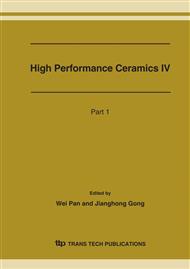p.1995
p.1999
p.2002
p.2005
p.2008
p.2012
p.2015
p.2017
p.2021
Nano-Scaled Anatase Phase Titanium Oxide Converted from Ammonium Oxotrifluorotitanate Prepared by Aqueous Solution of Ammonium Hexafluorotitanate and Boric Acid
Abstract:
Nano-scaled particle of anatase phase titanium oxide was obtained from the conversion of ammonium oxotrifluorotitanate by thermal treatment in oxygen. The crystal of ammonium oxofluorotitanate was grown on glass at 40oC with an aqueous solution of ammonium hexafluorotitanate and boric acid. The titanium oxide was obtained from the conversion of ammonium oxotrifluorotitanate by thermal treatment in oxygen. The size of nano-scaled anatase titanium oxide increases with the temperature of thermal treatment, and the size distribution is from 10 to 30 nm corresponding to the thermal temperature from 300 to 1000oC. The photocatalytic activity of the nano-scaled titanium oxide was demonstrated by the photo-deposition of copper in the solution of copper nitrate and sodium oxalate. The photocatalytic activity for the sample treated thermally at 800 oC is 1.3 times higher than that of commercial P-25.
Info:
Periodical:
Pages:
2008-2011
Citation:
Online since:
April 2007
Authors:
Keywords:
Price:
Сopyright:
© 2007 Trans Tech Publications Ltd. All Rights Reserved
Share:
Citation:


